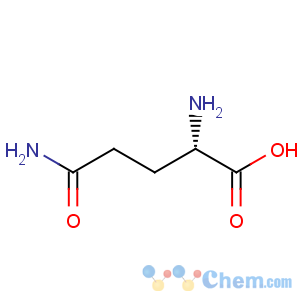Title: Glutamine
CAS Registry Number: 56-85-9
CAS Name: L-Glutamine
Synonyms: Gln; Q; 2-aminoglutaramic acid; (
S)-2,5-diamino-5-oxopentanoic acid; glutamic acid 5-amide
Trademarks: Cebrogen (Walker); Glumin; Levoglutamina; Stimulina
Molecular Formula: C5H10N2O3
Molecular Weight: 146.14
Percent Composition: C 41.09%, H 6.90%, N 19.17%, O 32.84%
Literature References: Non-essential amino acid for human development; most abundant free amino acid in plasma and tissue. Isoln from sugarbeet juice: E. Schulze, E. Bosshard,
Ber. 16, 312 (1883). Due to ease of conversion to glutamic acid,
q.v., it was not isolated from protein until 1932: M. Damodoran
et al., Biochem. J. 26, 1704 (1932). Early chemistry and biochemistry: R. M. Archibald,
Chem. Rev. 37, 161-208 (1945);
Amino Acids and Proteins, D. M. Greenberg, Ed. (Charles C. Thomas, Springfield, IL, 1951) 950 pp.,
passim; J. P. Greenstein, M. Winitz,
Chemistry of the Amino Acids vol 1-3 (John Wiley and Sons, Inc., New York, 1961) pp. 1929-1954,
passim. HPLC determn in biotech samples: B. Polanuer
et al., J. Chromatogr. 594, 173 (1992). Review of nutritive needs: R. J. Smith, D. W. Wilmore,
J. Parenter. Enteral Nutr. 14, (Suppl.) 94S-99S (1990); and metabolism: W. W. Souba,
J. Nutr. Biochem. 4, 2-9 (1993); L. M. Castell
et al., Amino Acids 7, 231-243 (1994). Review of metabolism and physiologic implications: R. J. Smith,
J. Parenter. Enteral Nutr. 14, (Suppl.) 40S-44S (1990); B. Moskovitz
et al., Pharmacol. Res. 30, 61-71 (1994).
Properties: Fine opaque needles from water or dil ethanol, dec 185-186°. [a]D23 +6.1° (c = 3.6). pK1 2.17; pK2 9.13. One gram dissolves in 20.8 ml water at 30°, in 38.5 ml at 18°, in 56.7 ml at 0°. Practically insol in methanol (3.5 mg/100 ml at 25°), ethanol (0.46 mg/100 ml at 23°), ether, benzene, acetone, ethyl acetate, chloroform.
pKa: pK1 2.17; pK2 9.13
Optical Rotation: [a]D23 +6.1° (c = 3.6)
Derivative Type: DL-Form
CAS Registry Number: 585-21-7
Literature References: Synthesis: F. E. King, D. A. A. Kidd,
J. Chem. Soc. 1949, 3315; G. B. Kline, S. H. Cox,
J. Org. Chem. 26, 1854 (1961).
Properties: Prisms from dil acetone, mp 185-186° (King); mp 173-174.5° (Kline). One gram dissolves in 38.5 ml water at 18°.
Melting point: mp 185-186° (King); mp 173-174.5° (Kline)

